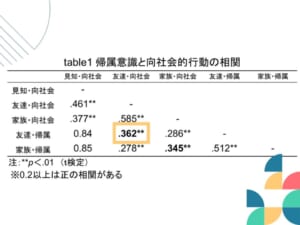- Science Castle Research Fund
- Announcements for middle and high school students
- Information for Teachers
- Digest of Oral Presentations
- Research Tips
With "friend" as a keyword, we unravel the action of "helping others! Science Castle 2023 Kansai Digest
2024.07.22![Unraveling the behavior of "helping others" with the keyword "friend"! [Digest of Science Castle 2023 Kansai Conference]</trp-post-container](https://s-castle.com/wp-content/uploads/sites/14/2024/07/0e30870f208f6d6e4552a3b1f1249435.jpg)
We will provide a digest of the "Science Castle," an academic conference for junior and senior high school students where the next generation of researchers are active, as well as the excitement of the field. In this issue, we report on the presentation by Mie Uemura, a second-year student at Nara Prefectural Seisho High School, who received the Daicel Award for her oral presentation at the Science Castle 2023 Kansai Conference!
Affiliation and grade are as of the time of the announcement.
Research "helping others without asking for anything in return."
I am studying the field of social psychology and prosocial behavior. Prosocial behavior is defined as "the behavior of trying to help or benefit others without expecting external rewards. Simply put, it is helping others without expecting anything in return.
Then there is attachment. Attachment can also mean "early childhood attachment" in home economics textbooks, but in this study, it refers to a sense of togetherness, pride, trust, belonging, and belonging.
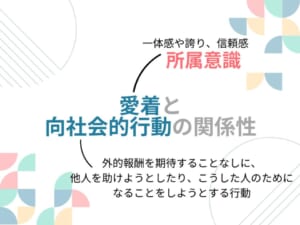
I began my research because I was attracted to an interesting index called the World Giving Index (Compassion Index). This index is published annually by CAF, a British charity organization, to determine the most compassionate countries in the world, and is based on three criteria, one of which is "helping strangers. Japan ranks 142nd out of 142 countries, in other words, at the bottom of the list. However, since this is a telephone survey, it lacks credibility.
Focus on "friends" based on the characteristics of the middle and high school student community.
For this study, I administered a questionnaire to first-year junior high school students through second-year high school students at my school, Nara Prefectural Seisho Junior and Senior High School. The questionnaire items are "prosocial behavior," "sense of belonging," "grade and gender," and "to whom did you do prosocial behavior. For example, if the subject was a family member, the survey asked whether they also helped their family members with household chores when their family members were doing them.
What we want to identify in this study are the characteristics of people who often act prosocially toward their friends. We dare to focus on friends. Middle and high school students have smaller, more intimate and unique communities of friends than adults or college students. Therefore, we believe that by focusing on this, a new angle will emerge.
So far, we have talked about prosocial behavior, but we have not mentioned attachment, which is the subject of the title. From this point on, we will talk about its relevance to attachment.
There is prior research showing that when people have a sense of belonging to the community in which they live, they will contribute to the community, which is a prosocial behavior. Now, let's change "community" to "friends" and see what happens. I thought that when people have a sense of belonging to their friends, they will engage in prosocial behavior toward their friends.
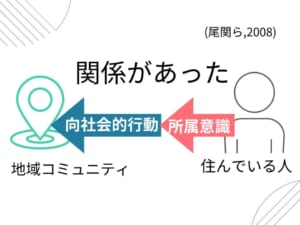
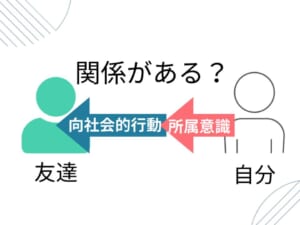
What are the characteristics of people who behave prosocially toward their friends? We hypothesized two hypotheses: first, that people who frequently engage in prosocial behavior toward friends may also engage in prosocial behavior toward family members and strangers, and second, that people who engage in prosocial behavior toward friends may have a sense of belonging toward their friends.
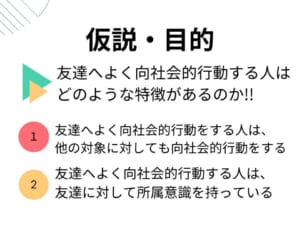
Do people who engage in societal behavior toward friends also engage in it toward strangers?
We will now discuss, results, and test our hypotheses. First, let's talk about the first hypothesis. This is the result of the correlation analysis. First, look at the red color on the left. There is a positive correlation between prosocial behavior toward strangers and prosocial behavior toward friends, 0.461. On the right is the prosocial behavior toward friends and the prosocial behavior toward family 0.585. Since there is a positive correlation, this alone shows that people who behave prosocially toward friends also do so toward family members and strangers.
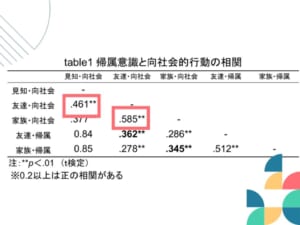
But is that enough? If we draw a distribution diagram, we find that it is not. First, on the left, prosocial behavior toward friends and family are distributed close together, but look at the right. The right side shows that the distribution is quite uneven. The vertical axis shows prosocial behavior toward friends and the horizontal axis shows prosocial behavior toward strangers. The upper panel is for those who often exhibit prosocial behavior toward their friends, but the horizontal axis is for those who often exhibit prosocial behavior toward strangers. In other words, people who often engage in prosocial behavior toward friends may or may not do so toward strangers. But look at the bottom left. It's pretty well organized, isn't it? This means that people who do not engage in prosocial behavior toward friends do not do it toward strangers either. These results show that people who often act prosocially toward friends also do it toward family members, but some do it toward strangers and some don't, and those who don't do it don't do it toward anyone.
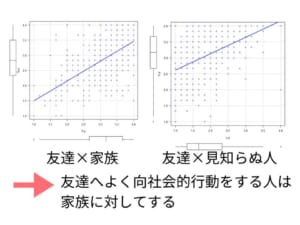
Relationship between sense of belonging to friends and prosocial behavior
Next, we will test the second hypothesis. This is a summary of the prosocial behavior toward friends and the sense of belonging to friends. 0.362, a weak correlation was found, and a Mann-Whitney u-rights hypothesis test was conducted, which confirmed a significant difference. When I drew a scatter plot, it was again scattered. The vertical axis is the sense of belonging to friends and the horizontal axis is the prosocial behavior toward friends, but the upper part is quite scattered.
This is calculated from a hypothesis test, so it is relevant, but why didn't it work? When I thought about it, I realized that the reason may have been that I had not defined "friends" in the questionnaire. Whether to imagine a group or an individual, we believe this was a factor that greatly changed the results of the study. However, it was often the case that when people had a sense of belonging toward their friends, they often engaged in prosocial behavior toward their friends.
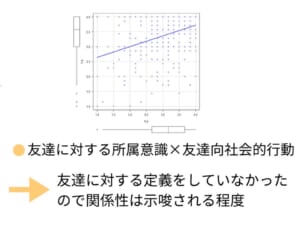
In summary, people who often act prosocially toward friends do so toward family members, but toward strangers, depending on the person. However, those who do not do it do not do it to anyone. People who often engage in prosocial behavior toward friends may have a sense of belonging toward them. The reason why we stop at possible is because we did not define friends and family. If we had defined this, it might have been more innovative, or it might have produced the exact opposite result. References are listed below. Thank you for your attention.
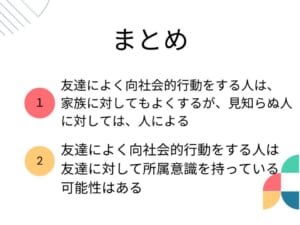
question and answer session
Kenichi Matsumoto (Nara Institute of Science and Technology):
What do you find interesting about researching humans and their structures, and conversely, what do you find a little difficult?
Miyu Kamimura:
The difficult part is that there are many external factors. It is not easy to limit them compared to living organisms. That part was a bit difficult. For example, the sense of belonging to a family has a correlation of 0.278, which is weaker than the prosocial behavior toward friends, and I wondered why this result was obtained, and it occurred to me that it was due to the small size of the community of junior high and high school students. But we don't know that because we didn't take a survey. It is only imaginary. So I still think that the fact that there are so many external factors involved in this kind of research dealing with "people" is a very difficult point.
The interesting part was that there were many times when I researched something that I thought was obvious, but in fact it was quite different. On the other hand, there were quite a few cases where I thought, "This is really true. For example, if the results showed that when people have a sense of belonging to their friends, they often act in a prosocial manner toward them, it would seem that this is true. But when I drew a scatter plot, the results were different.
Taiyo ANZAЇ (Osaka Public University):
You are interested in friends and belonging. From a different perspective, I think the awareness of helping changes depending on whether the stranger is a man, a woman, or a child. If it is a small child, there is a sense of helping even if it is a stranger. I thought it would be possible to examine this issue more deeply if we combine the perspective of "helping any person" with gender, age, and other factors.
Miyu Kamimura:
As I said, there was a significant impact from the fact that we did not define it in the course of our research. For example, I think that if we had asked when they engaged in prosocial behavior in an open-ended question when we were conducting the survey, we would have obtained different results.
Toshihiro Ishizawa (Liverness Corporation):
It is often said that Japanese people are shy. I was listening to them, imagining that they would be ranked so very low. I think it would be interesting to see a correlation between whether people are more or less likely to talk to strangers and their sense of belonging if we analyze the differences between classes, just as there are some classes that are very lively and others where no questions are raised.
Miyu Kamimura:
Something similar is the bystander effect, the so-called "if the people around you don't do anything, you don't do anything either. It would be interesting to incorporate this, but it is quite difficult to conduct a survey on the bystander effect itself. From now on, I would like to conduct research with an eye to areas such as motivation and motivation.
(*Honorifics omitted)

